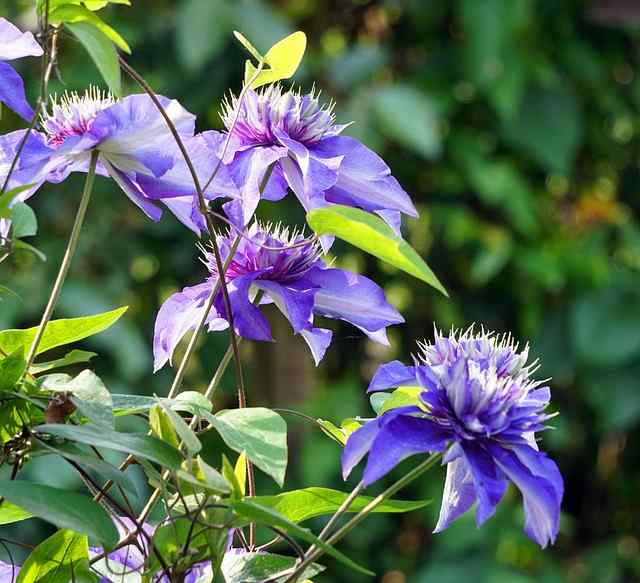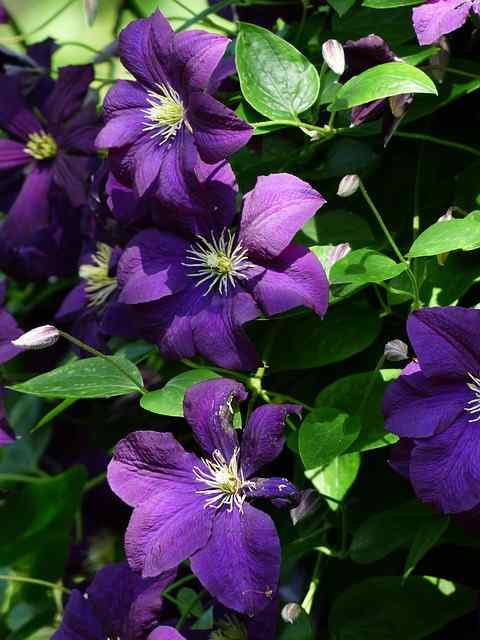This comprehensive guide will explore the nuances of planting clematis in the fall, exploring the benefits, challenges, and expert tips for success.
The Growing Seasons of Clematis

Clematis can be categorized into three main groups based on their flowering patterns – early bloomers, late bloomers, and those that flower in both spring and summer. Early bloomers typically flower on previous year’s growth, while late bloomers blossom on current year’s growth. Understanding these categories is crucial for determining the right planting time and care practices to ensure your clematis thrives.
Understanding Fall Planting

The Concept of Fall Planting
Planting in the fall is an age-old gardening practice that comes with various advantages. As temperatures begin to cool, plants experience less stress compared to the hotter, drier conditions of summer. Fall planting allows the root systems to establish before winter, optimizing growth once spring arrives. However, this optimal timing can significantly vary from plant to plant.
The Pros of Planting Clematis in Fall
Root Establishment: One of the greatest benefits of fall planting is the opportunity for roots to establish without the stress of competing with hot temperatures and drought conditions. As the soil cools, it retains moisture better, which is crucial for a newly planted clematis. A robust root system sets the stage for vigorous growth in the following spring.
Less Competition: As other plants begin to die back in the fall, planting clematis becomes less contentious. With fewer plants vying for nutrients and light, your clematis will have a better chance for robust growth.
Time for Growth: Fall planting positions the clematis to begin growing as soon as temperatures rise again in the spring. By the time warmer weather returns, your clematis will be more established and can burst into life sooner than spring-planted options.
Less Pruning Needed: Often, if you plant in the fall, there’s less pruning required in spring. When the clematis is in its dormant stage, you can assess where cuts may need to be made for health, while still allowing for continuous growth come springtime.
Reduced Watering Needs: With lighter watering requirements in fall due to cooler temperatures and potential seasonal rainfall, it can be easier for gardeners to care for newly planted clematis.
The Challenges of Fall Planting
While there are notable advantages to planting clematis in the fall, a few challenges also exist.
Freezing Temperatures: One of the primary concerns is the risk of early frost. If a young clematis is planted too late into the season, it might struggle to adapt to the dropping temperatures. Carefully timing your planting—generally around six weeks before the ground freezes—is essential.
Shallow Rooting: If planted too late, young clematis may develop shallow roots, making them susceptible to frost damage. This makes it essential to ensure proper planting depth and positioning before winter sets in.
Waterlogging: In some regions, early fall can bring heavy rains. If the soil becomes waterlogged, it poses a threat of root rot and other fungal issues. It’s essential to select well-draining soil to mitigate this risk.
Key Considerations for Planting Clematis in the Fall

To successfully plant clematis in the fall, consider these essential factors:
1. Timing
The timing of your planting is critical. The best time to plant clematis in the fall is typically around late September to October, depending on your region. Aim to get your clematis in the ground at least six weeks before the first expected frost. This allows the roots to establish before becoming dormant.
2. Soil Preparation
Clematis thrive in well-draining, nutrient-rich soil. Before planting, consider amending your soil with organic matter, like compost or well-rotted manure, to improve texture and fertility. Conducting a soil test can also provide insights into pH levels and nutrient availability; clematis generally prefers slightly acidic to neutral pH.
3. Planting Depth
Clematis should be planted deeper than they were in the nursery. When planting clematis, bury the crown (where the stem meets the roots) approximately 2-3 inches below the soil surface. This encourages robust root development and protects against winter frost.
4. Watering
Proper watering is paramount. After planting, give the clematis a thorough watering to help settle the soil around the roots. You may need to maintain moisture through any dry spells, but avoid overwatering to prevent rot.
5. Mulching
Mulching serves multiple purposes. A layer of mulch around the base of your newly planted clematis will help retain soil moisture, suppress weeds, and regulate soil temperature throughout the winter months. Aim for a 3-4 inch layer of organic mulch, like shredded bark or straw.
6. Protection from Winter Elements
In regions with harsh winters, protecting your clematis plant is vital. You may want to cover the base with additional mulch or straw as temperatures plunge. This acts as insulation against frost and harsh temperatures, allowing for a smooth transition into spring.
7. Choosing the Right Varieties
Some varieties of clematis are better suited for fall planting than others. While most will do well if planted with care, consider selecting hardy varieties such as Clematis ‘Nelly Moser’ or Clematis ‘Jackmanii’, which are known for their resilience and quick establishment.
Post-Planting Care: What to Expect in Fall and Winter

Once you have successfully planted your clematis, it’s essential to provide appropriate care as it transitions into winter. This involves ongoing monitoring of soil moisture and humidity levels, as well as observing the overall health of your plant.
Monitoring Soil Moisture
Even during fall and winter, it’s critical to monitor the soil moisture level. Water your clematis during particularly dry spells, but refrain from overwatering, as this can be detrimental and lead to root rot.
Seasonal Watering
As the plant enters dormancy, the water needs will decrease significantly. Pay attention to the weather – natural rainfall can often suffice, but don’t hesitate to water if conditions remain dry.
Assessing Winter Protection Needs
As winter approaches, continuously assess the need for protection against frost. The mulch layer you’ve applied should be sufficient, but be ready to add additional insulation or protection if unusually severe weather is forecasted.
Patience Until Spring
During the colder months, patience is vital. It may seem like nothing is happening with your clematis, but rest assured, the roots are digging deeper, preparing for the explosive growth that typically happens in spring.
Spring Surprise: What to Expect After Winter

As the frost begins to thaw and the days grow longer, your clematis will eventually break dormancy. Here’s what to anticipate come springtime:
1. New Growth
You should start to see fresh growth emerging from the plant, usually in the form of new shoots coming up from beneath the soil. This is an encouraging sign that your clematis has successfully established itself over the winter.
2. Pruning Practices
Depending on the variety of clematis, you may need some pruning. For early bloomers, prune only when the flowers have faded. Late blooming varieties can be pruned more vigorously, as they flower on new growth. The key is to familiarize yourself with your specific variety to understand its growth pattern.
3. Fertilizing
As your clematis begins to grow, consider applying a balanced fertilizer to support its development. Organic options are often gentler and more beneficial in the long run. Look for fertilizers specifically labeled for flowering plants or those rich in potassium and phosphorus.
4. Ongoing Care
Continue regular watering, particularly during dry spells in spring and summer. Ensure your clematis has ample sunlight – they generally require at least 6 hours of direct sunlight each day.
Conclusion: Should You Plant Clematis in Fall?
To answer the question posed at the beginning of our journey, yes, you can plant clematis in the fall! With diligent planning and a little care, fall is an excellent time to introduce these stunning climbers to your garden.





